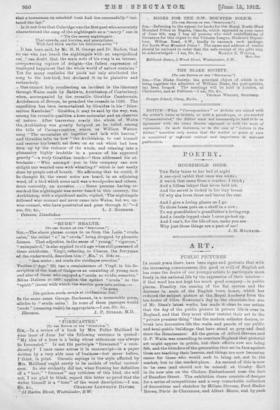ART.
PUBLIC PICTURES.
IN recent years there have been 'signs and portents that with the increasing consciousness (for good or evil) of English art. has come the desire of our younger artists to participate more freely,in the national life by the expression of their mission— if that word has not kept too much good company—in public, places. Possibly the coming of the flat system and the decrease in Beale of the English town house, which has reduced the subject picture at the, Royal Academy from the ten-footer of Clive Newcome's day to the chocolate-box size of Mr. Sims's latest works, has made -it clear to our artists that the day of the public picture in private life is over in England, and that they must either restrict their art to the "private precious thing" that the modern collector desires, or break into decorative life the walls and panels of our public and semi-public buildings that have •stood so grey and dead since the Renaissance. All the genius of Alfred Stevens and G. F. Watts was unavailing to convince England that pictorial art might appear in public, but their efforts now are being felt, and the blunders of the generation that set its face against them are teaching their lessons, and things are now becoming easier for those who would seek to bring art, not to the market, but to the market-place. An earnest of this is now to be seen (and should not be missed) at Crosby Hall in its new site on the Chelsea Embankment near the foot of Beaufort Street. The exhibition there consists of designs for a aeries of competitions and a very remarkable collection of decorations and sketches by Millais, Stevens, Ford Madox Brown, Pnvis de Cheyennes, and Albert Moore, and by such living artists as Mr. John Sargent, Mr. William Strang, Mr. Alining Bell, and Mr. Walter Crane. The committee respon- sible for the exhibition is ,43, far-seeing and influential one, including, as it does, Mr. D. S. MaeColl, Mr. Charles Aitken, Mr. Sargent, Professor Sadler, Professor Lethaby, Mr. Halsey Ricardo, Mr. Roger Fry, Mr. Edmund Davis, and Dr. Kimmins. They have inspired various public-spirited persons and institutions to offer prizes for suitable decora- tions for their walls, and when one remembers how Watts was refused permission by the London and North Western Railway to decorate Euston Station hall at his own expense it is clear that either the spirit of the time has changed or that the committee has miraculous powers of persuasion—possibly a little of both.
If the designs sent in do not impress one as representative of the best that the younger Londonartists of the time have to offer, they certainly show that spirited ideas of decoration and decent draughtsmanship are not uncommon. Mr. Augustus John, among his achievements, has fired the mind of our art students with a sense of the primitive basis of things, of simplified drapery, common yet noble in ,effect, and in the subordination of everything to gesture. In the cartoons for the three panels in the Dublin National Gallery for which Sir Hugh Lane offers a prize of E100 each the most ambitious designs occur. A very capable composition of The Meeting of Cuchullin and Enter by " Celt," which would have been improved by a strongly coloured background, a weaker but more beautifully drawn composition of The .Wooing of Erner by "Emot," and a brilliant, strongly contracted design of Deirdre and Naisi by " Every Cloud has a Silver Lining," are all stalwart attempts on their subjects. The most imaginative ideas, however, are in the smaller cartoons by "King Arthur," with three figures with wild black hair, and in the streaming idea of figures and rushing clouds by "Paint Bender." However, in some examples on the other side of the ball we see how easily the strangeness and force of a design on a- small scale may become rather flatulent on big scale. The designs for the dining-room in Messrs. Grosse and Blackwell'a factory which give the artists an incentive to look freshly into modern life show most originality, " Wage- Earner's" compositions of labelling bottles and »inking pickles revealing a very entertaining convention of straight lines, especially in the high lights on the girls' " waved " hair. Other designs are for decorations for a village hall in Berk- shire, a school at Sutton Valence, and the vestibule of Middlesex Hospital; for London County Council schools and for Mr. Lutyens' beautiful Church of St. Jude's in the Hampstead Garden Suburb. This exhibition and its objects are certainly worth the attention-and support of -all -who care
seriously for the development of our art. .J..B.











































 Previous page
Previous page